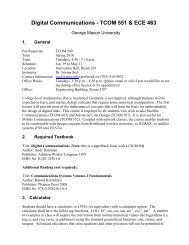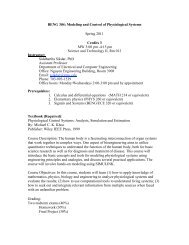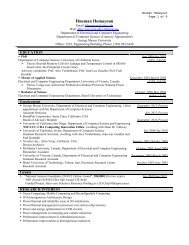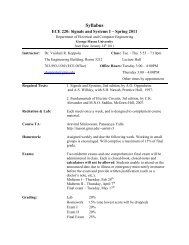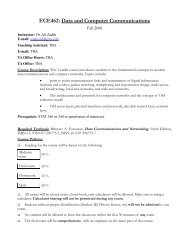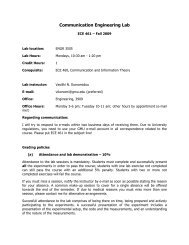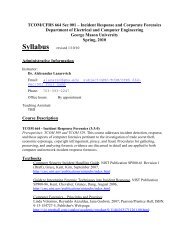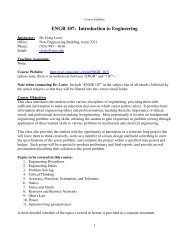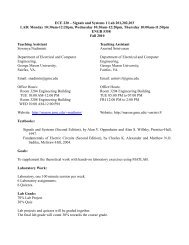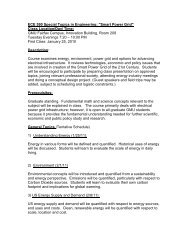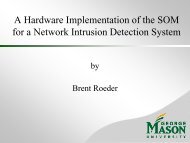ECE 590 Topics in Bioengineering: Biomedical Signal Processing ...
ECE 590 Topics in Bioengineering: Biomedical Signal Processing ...
ECE 590 Topics in Bioengineering: Biomedical Signal Processing ...
You also want an ePaper? Increase the reach of your titles
YUMPU automatically turns print PDFs into web optimized ePapers that Google loves.
<strong>ECE</strong> <strong>590</strong> <strong>Topics</strong> <strong>in</strong> Bioeng<strong>in</strong>eer<strong>in</strong>g: <strong>Biomedical</strong> <strong>Signal</strong> Process<strong>in</strong>g<br />
<strong>ECE</strong> 699 Advanced <strong>Topics</strong> <strong>in</strong> <strong>Biomedical</strong> <strong>Signal</strong> Process<strong>in</strong>g<br />
Fall 2008<br />
Credits 3<br />
Tuesdays, 7:20 pm – 10:00 pm, Room: Science and Tech II, 260<br />
Instructor:<br />
Siddhartha Sikdar, PhD<br />
Assistant Professor<br />
Department of Electrical and Computer Eng<strong>in</strong>eer<strong>in</strong>g<br />
Volgenau School of IT&E<br />
Office: Science and Tech II, Room 207B<br />
Email: ssikdar@gmu.edu<br />
Phone: 703-993-1539<br />
Office hours: Tuesdays 2:00-4:00 pm and by appo<strong>in</strong>tment<br />
Course description (<strong>ECE</strong> <strong>590</strong> and <strong>ECE</strong> 699):<br />
Our modern healthcare system relies critically on the analysis of physiological<br />
signals from electronic sensors and <strong>in</strong>struments to save lives and monitor the health of<br />
patients <strong>in</strong> a wide variety of applications and sett<strong>in</strong>gs. Examples <strong>in</strong>clude automatic cardiac<br />
defibrillators commonly found <strong>in</strong> many public places, which automatically deliver a lifesav<strong>in</strong>g<br />
electric shock to a patient; Doppler ultrasound <strong>in</strong>struments <strong>in</strong> the hospital that<br />
non<strong>in</strong>vasively measure blood flow <strong>in</strong>side the body; or the heart-rate monitor on the<br />
treadmill at the local gym. <strong>Biomedical</strong> signals are typically nonstationary, have complex<br />
features, and the cl<strong>in</strong>ically relevant <strong>in</strong>formation is often masked by noise and other<br />
<strong>in</strong>terfer<strong>in</strong>g signals. This course will provide an <strong>in</strong>troduction to the characteristics of<br />
biomedical signals, describe applications <strong>in</strong>volv<strong>in</strong>g the analysis of these signals, and<br />
discuss several signal process<strong>in</strong>g and analysis methods with specific biomedical examples.<br />
The students will get hands-on experience <strong>in</strong> apply<strong>in</strong>g the methods learnt <strong>in</strong> class to realworld<br />
problems. A course project will provide the opportunity to <strong>in</strong>dividually or<br />
collaboratively explore current problems <strong>in</strong> biomedical signal analysis.<br />
<strong>ECE</strong> 699 (Advanced <strong>Topics</strong>) option:<br />
This course also has an <strong>ECE</strong> 699 option for students desir<strong>in</strong>g 600-level credits.<br />
The course content, homework and exams for <strong>ECE</strong> 699 would be the same as that for<br />
<strong>ECE</strong> <strong>590</strong>. Students tak<strong>in</strong>g <strong>ECE</strong> 699 would be expected to do a more advanced project<br />
demonstrat<strong>in</strong>g <strong>in</strong>-depth understand<strong>in</strong>g and critical assessment of methods from recent<br />
research literature and would be required to submit a project report.<br />
Learn<strong>in</strong>g objectives:
At the end of the course the student should be able to:<br />
1. Describe the characteristics of biomedical signals and the need for their analysis.<br />
2. Demonstrate an appreciation of physiological processes underly<strong>in</strong>g the<br />
production of biomedical signals and their measurement.<br />
3. Apply filter<strong>in</strong>g, spectral estimation, signal model<strong>in</strong>g and nonstationary analysis<br />
techniques for process<strong>in</strong>g biomedical signals.<br />
4. Design signal-process<strong>in</strong>g algorithms to solve real-world problems <strong>in</strong>volv<strong>in</strong>g<br />
biomedical signals.<br />
Prerequisites:<br />
1. Familiarity with MATLAB<br />
2. <strong>Signal</strong> process<strong>in</strong>g (<strong>ECE</strong> 535 or equivalent) or permission of <strong>in</strong>structor.<br />
3. Random processes (<strong>ECE</strong> 528 or equivalent) or permission of <strong>in</strong>structor.<br />
Resources:<br />
Course home page:<br />
The course material distribution, assignments grad<strong>in</strong>g, announcements and<br />
discussion boards will be managed us<strong>in</strong>g BlackBoard CE6. To access the course home<br />
page, log <strong>in</strong> us<strong>in</strong>g your email ID and password on http://courses.gmu.edu. If you have<br />
difficulties us<strong>in</strong>g this system, please speak with the <strong>in</strong>structor and appropriate<br />
accommodations will be considered.<br />
Required read<strong>in</strong>gs:<br />
The lecture slides will be the basis of material covered <strong>in</strong> lectures and will be<br />
posted before the class. Additional read<strong>in</strong>g and reference material will be distributed to<br />
students through the course web site periodically.<br />
Textbook (recommended):<br />
Eugene Bruce: <strong>Biomedical</strong> <strong>Signal</strong> Process<strong>in</strong>g and <strong>Signal</strong> Model<strong>in</strong>g, Wiley 2000.<br />
Additional textbooks for reference:<br />
Rangaraj M. Rangayyan: <strong>Biomedical</strong> <strong>Signal</strong> Analysis: A Case-study Approach, IEEE<br />
Press, 2002.<br />
Petre Stoica and Randolph Moses: Spectral Analysis of <strong>Signal</strong>s, Prentice Hall, 2005.<br />
Course structure:<br />
The course will consist of weekly lectures, homework assignments, two exams, a<br />
f<strong>in</strong>al project and a f<strong>in</strong>al presentation (details below). In addition, <strong>ECE</strong> 699 students will<br />
be required to submit a written project report. The exams will be closed book and closed<br />
notes.
Grade:<br />
Midterm exam 25%<br />
F<strong>in</strong>al exam 25%<br />
Homework 25%<br />
F<strong>in</strong>al project and presentation 25%<br />
F<strong>in</strong>al Project (<strong>ECE</strong> <strong>590</strong>):<br />
The f<strong>in</strong>al project will <strong>in</strong>volve hands-on experience with develop<strong>in</strong>g or<br />
implement<strong>in</strong>g signal-process<strong>in</strong>g algorithms for a solv<strong>in</strong>g a particular biomedical signal<br />
analysis problem. Students should select a topic, discuss with the <strong>in</strong>structor, and get<br />
approval with<strong>in</strong> the first five weeks of class. Students can select one of the follow<strong>in</strong>g<br />
approaches:<br />
1) Implement a specific algorithm for biomedical signal process<strong>in</strong>g from recent literature,<br />
demonstrate its uses us<strong>in</strong>g real data and suggest avenues for improvement.<br />
2) Develop a signal process<strong>in</strong>g algorithm for solv<strong>in</strong>g a specific problem <strong>in</strong>volv<strong>in</strong>g<br />
biomedical signals. Available functions from MATLAB toolboxes can be used where<br />
appropriate, and the f<strong>in</strong>al result should be demonstrated us<strong>in</strong>g real data.<br />
Students with similar <strong>in</strong>terests can choose to work together on a more complex<br />
project (the contribution of each student should be clearly def<strong>in</strong>ed). An annotated<br />
bibliography of relevant literature sources should be submitted to the <strong>in</strong>structor for<br />
approval by the seventh week of class.<br />
At the end of the semester, students will be expected to make a 20-m<strong>in</strong><br />
presentation/demonstration of their f<strong>in</strong>al project. Your classmates will grade the f<strong>in</strong>al<br />
presentation. Grades for the presentation and the f<strong>in</strong>al report will be based on: clarity of<br />
<strong>in</strong>troduction, quality of results, depth of analysis and discussion.<br />
Project deliverables:<br />
1. Annotated bibliography of literature sources (due by 7 th week)<br />
2. Weekly progress reports (start<strong>in</strong>g from the 10 th week)<br />
3. Work<strong>in</strong>g MATLAB or C/C++ code and properly documented results<br />
4. Project presentation<br />
F<strong>in</strong>al Project (<strong>ECE</strong> 699):<br />
The f<strong>in</strong>al project for students tak<strong>in</strong>g <strong>ECE</strong> 699 will <strong>in</strong>volve hands-on experience<br />
with develop<strong>in</strong>g or implement<strong>in</strong>g signal-process<strong>in</strong>g algorithms for a solv<strong>in</strong>g a particular<br />
biomedical signal analysis problem as well as exposure to the recent research literature.<br />
The project should <strong>in</strong>volve an <strong>in</strong>-depth study and critical assessment of one or more<br />
methods from recent literature. Students should select a real-world problem <strong>in</strong>volv<strong>in</strong>g<br />
biomedical signals, discuss with the <strong>in</strong>structor, and get approval with<strong>in</strong> the first five<br />
weeks of class. By the seventh week, the students are expected to do a thorough literature<br />
search and identify methods that have been proposed to solve the problem. Based on this<br />
literature review, students can choose either to:<br />
1) Implement a specific algorithm for biomedical signal process<strong>in</strong>g from recent literature,<br />
demonstrate its uses us<strong>in</strong>g real data and suggest avenues for improvement.
2) Critically compare two or more methods and discuss the pros and cons of each<br />
method.<br />
Students with similar <strong>in</strong>terests can choose to work together on a more complex<br />
project (the contribution of each student should be clearly def<strong>in</strong>ed).<br />
At the end of the semester, students will be expected to make a 20-m<strong>in</strong><br />
presentation/demonstration of their f<strong>in</strong>al project. Your classmates will grade the f<strong>in</strong>al<br />
presentation. Grades for the presentation and the f<strong>in</strong>al report will be based on: clarity of<br />
<strong>in</strong>troduction, quality of literature review, quality of results, depth of analysis and<br />
discussion.<br />
In addition, <strong>ECE</strong> 699 students are expected to submit a written project report (5-<br />
10 pages) with separate sections for Introduction, Methods, Results and Discussion.<br />
Project deliverables:<br />
1. Annotated bibliography of literature sources (due by 7 th week)<br />
2. Weekly progress reports (start<strong>in</strong>g from the 10 th week)<br />
3. Work<strong>in</strong>g MATLAB or C/C++ code and properly documented results<br />
4. Project presentation<br />
5. Project report<br />
Homework:<br />
There will be assigned homework throughout the semester. The homework will<br />
<strong>in</strong>volve process<strong>in</strong>g and analysis of real signals, and will <strong>in</strong>volve programm<strong>in</strong>g <strong>in</strong><br />
MATLAB. Homework submitted after the due date will be penalized (15% penalty for<br />
each day late). No homework will be accepted after one week from the due date.<br />
5 po<strong>in</strong>ts of the homework grade is reserved for class participation. One student<br />
will be assigned each week on a rotat<strong>in</strong>g basis to take the lead on compil<strong>in</strong>g a summary of<br />
the discussions <strong>in</strong> class. The student should compare notes with other students and post<br />
their summary on the discussion board on the class home page. These summaries should<br />
be used as a supplement to the lecture slides <strong>in</strong> prepar<strong>in</strong>g for exam<strong>in</strong>ations. The class<br />
participation grade will be based on the quality of these discussion summaries.<br />
Exams:<br />
The midterm and f<strong>in</strong>al exams will be closed book and notes. They will consist of a<br />
mixture of essay-type and multiple-choice type questions. Absence from exams must be<br />
notified ahead of time and alternative arrangements made with the <strong>in</strong>structor.
Syllabus<br />
Week Date Topic Important<br />
deadl<strong>in</strong>es<br />
1 8/26/08 Introduction; nature of biomedical signals and<br />
<strong>in</strong>struments; why do we need biomedical signal analysis?<br />
2 9/02/08 Examples of biomedical signals and the underly<strong>in</strong>g<br />
physiological processes.<br />
3 9/09/08 Review of random processes, stationarity and ergodicity,<br />
noise.<br />
4 9/16/08 <strong>Signal</strong> characteristics: autocorrelation, crosscorrelation,<br />
covariance, power spectral density, cross-spectral<br />
density, coherence.<br />
5 9/23/08 Filter<strong>in</strong>g biomedical signals: FIR and IIR filters, ensemble<br />
averag<strong>in</strong>g, frequency doma<strong>in</strong> filter<strong>in</strong>g.<br />
6 9/30/08 Filter<strong>in</strong>g biomedical signals: trend removal, artifact<br />
removal, noise reduction.<br />
7 10/07/08 Event detection: correlation, matched filter<strong>in</strong>g, coherence<br />
analysis.<br />
Paper topic<br />
approval due<br />
List of<br />
literature<br />
sources due<br />
8 10/14/08 No class: Columbus day recess<br />
9 10/21/08 Mid-term Exam<br />
10 10/28/08 <strong>Biomedical</strong> signal model<strong>in</strong>g: Fourier series, basis<br />
functions.<br />
11 11/04/08 <strong>Biomedical</strong> signal model<strong>in</strong>g: parametric model<strong>in</strong>g, Yule-<br />
Walker equations, AR, MA and ARMA processes.<br />
12 11/11/08 Spectral estimation: periodogram methods, w<strong>in</strong>dow<strong>in</strong>g,<br />
spectral resolution, spectral leakage.<br />
13 11/18/08 Nonstationary signal analysis: short-time fourier<br />
transforms.<br />
14 11/25/08 Nonstationary signal analysis: time-frequency methods,<br />
wavelets.<br />
15 12/02/08 Examples of feature extraction and computer-aided<br />
diagnosis. Course wrap up.<br />
16 12/09/08 F<strong>in</strong>al presentations. Project report<br />
for <strong>ECE</strong> 699<br />
due.<br />
16 12/16/08 F<strong>in</strong>al exam.
Academic Honesty and Collaboration:<br />
The <strong>in</strong>tegrity of the University community is affected by the <strong>in</strong>dividual choices<br />
made by each of us. GMU has an Honor Code with clear guidel<strong>in</strong>es regard<strong>in</strong>g academic<br />
<strong>in</strong>tegrity. Three fundamental and rather simple pr<strong>in</strong>ciples to follow at all times are that:<br />
(1) all work submitted be your own; (2) when us<strong>in</strong>g the work or ideas of others, <strong>in</strong>clud<strong>in</strong>g<br />
fellow students, give full credit through accurate citations; and (3) if you are uncerta<strong>in</strong><br />
about the ground rules on a particular assignment, ask for clarification. No grade is<br />
important enough to justify academic misconduct.<br />
With collaborative work, names of all the participants should appear on the work.<br />
Collaborative projects may be divided up so that <strong>in</strong>dividual group members complete<br />
portions of the whole, provided that group members take sufficient steps to ensure that<br />
the pieces conceptually fit together <strong>in</strong> the end product. Other projects are designed to be<br />
undertaken <strong>in</strong>dependently. In the latter case, you may discuss your ideas with others and<br />
conference with peers; however, it is not appropriate to give your work to someone else<br />
to review. You are responsible for mak<strong>in</strong>g certa<strong>in</strong> that there is no question that the work<br />
you hand <strong>in</strong> is your own. If only your name appears on an assignment, your professor<br />
has the right to expect that you have done the work yourself, fully and <strong>in</strong>dependently.<br />
Plagiarism means us<strong>in</strong>g the exact words, op<strong>in</strong>ions, or factual <strong>in</strong>formation from<br />
another person without giv<strong>in</strong>g the person credit. Writers give credit through accepted<br />
documentation styles, such as parenthetical citation, footnotes, or endnotes.<br />
Paraphrased material must also be properly cited. A simple list<strong>in</strong>g of books or articles is<br />
not sufficient. Plagiarism is the equivalent of <strong>in</strong>tellectual robbery and cannot be tolerated<br />
<strong>in</strong> the academic sett<strong>in</strong>g. If you have any doubts about what constitutes plagiarism, please<br />
see the <strong>in</strong>structor.<br />
Relevant Campus and Academic Resources<br />
Disability Services<br />
Any student with documented learn<strong>in</strong>g disabilities or other conditions that may<br />
affect academic performance should: 1) make sure this documentation is on file with the<br />
Office of Disability Services (SUB I, Rm. 222; 993-2474; www.gmu.edu/student/drc) to<br />
determ<strong>in</strong>e the accommodations you might need; and 2) talk with the <strong>in</strong>structor to discuss<br />
reasonable accommodations.<br />
Office of Diversity Programs and Services<br />
SUB 1, Rm. 345; 993-2700; www.gmu.edu/student/msaf/<strong>in</strong>dex.html<br />
Writ<strong>in</strong>g Center<br />
Rob<strong>in</strong>son A116; 993-1200; writ<strong>in</strong>gcenter.gmu.edu.



